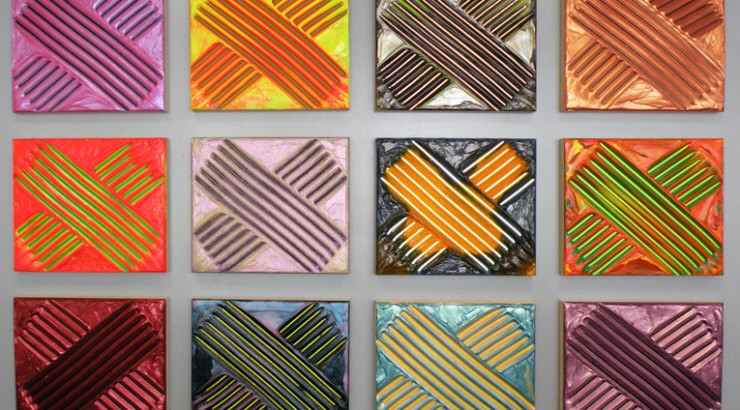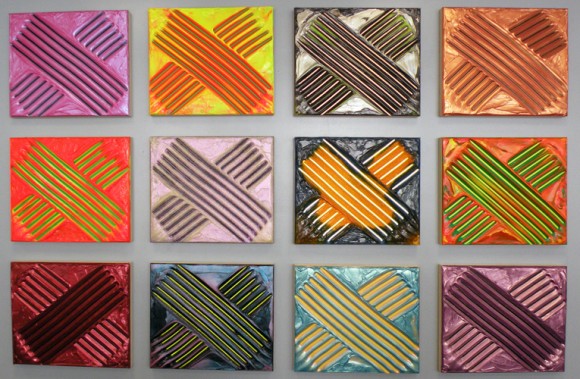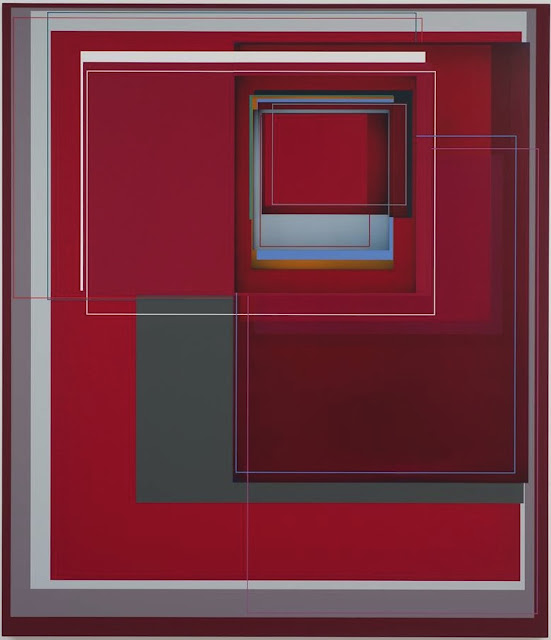
Compare and Contreras
March 25, 2015
Contemporary artists Albert Contreras and Patrick Wilson seem to create distinctly different works of art, yet share surprising common ground in at least one aspect of their creative processes.

Albert Contreras
Untitled
Acrylic on panel, 2009-10
When creating his iconic “X” paintings, Contreras begins with custom wood panels. He paints on a layer of gesso, then one of glittery white gloss. Once those layers are dry, Contreras starts his process by pouring copious amounts of acrylic paint onto the board. He then spreads the paint out to the edges of the panel, trying to make the thick coat as even as possible on all sides. He creates his x-shapes with a custom tool: a wooden-handled, jagged piece of plexiglass that he drags twice across the panel. The result is a large, exciting “X” consisting of thick, grooved lines. Contreras drags the tool through the paint with what he describes as “energy and determination,” adjectives that apply both to his process as well as to the final product. After creating the shape and scraping off excess paint, Contreras leaves the painting alone to dry. A single painting requires nearly eight quarts of the expensive paint and takes one to two months to dry.

Patrick Wilson
Red Emperor
Acrylic, 2010
Patrick Wilson is known for his geometrical, incredibly precise paintings. Wilson creates these pieces in a very unique way—though he begins with a basic sketch, he improvises as he goes. He uses drywall blades measuring anywhere from one to three feet in width, pushing and pulling the paint across the canvas, repeating this process over and over again. Each layer of paint is thin, allowing for variations in color, ranging from more translucent to opaque. This painstaking process results in a painting with varying fields of color, as well as several small levels of paint buildup, creating a vaguely three-dimensional feel.
The creative processes of Albert Contreras and Patrick Wilson can be described as completely different yet oddly similar. The most obvious difference is in the final products—while Contreras’ “X” paintings are active and dynamic, Wilson’s geometric pieces are calm and calculated. However, both artists’ processes are spontaneous in their own ways. Wilson is spontaneous in that while he begins with an initial concept sketch, he allows himself to change the design as he goes. Contreras’ spontaneity, on the other hand, takes a front seat in his paintings, as he creates his shapes swiftly and does not alter them. Wilson’s spontaneity occurs slowly and meticulously, while that of Contreras occurs quickly and suddenly. It is unexpected that two extremely different artists with different creative processes could share the common idea of spontaneity.

